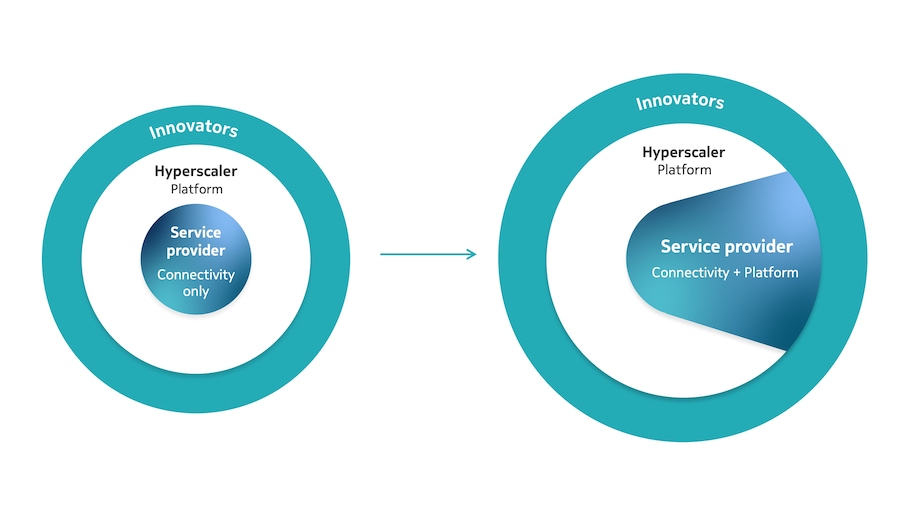Technology strategy
Shaping the hyper-digital world
As we approach 2030, we see a hyper-digital world on the horizon.
Advanced technologies will seamlessly integrate into every aspect of life, bringing about transformative changes across our society. Artificial intelligence will detect threats before they appear and accelerate drug discovery by analyzing vast datasets. Electric vehicles will become mobile energy storage units, interacting with the grid for optimal energy management and greater sustainability.
The acceleration of innovation and the evolution of advanced technologies present both opportunities and challenges. Together, we need to build infrastructures and platforms that are capable of not only supporting the future but also delivering unique solutions, services and business models.
- Overview
- Revolutionary platforms are a service provider’s path to growth
- Platforms underpinned by four emerging technology phenomena
- The next generation of network architecture
- From legacy to future network architecture
- Everything hinges on network evolution
- 2030 and beyond: The future starts today
- Explore our insights
Revolutionary platforms are a service provider’s path to growth
To take advantage of the unfolding digital opportunity and stay competitive, service providers must transition from simply delivering connectivity to becoming enablers of digital ecosystems.
Service providers must adopt a ‘cognitive platform approach’, integrating the network-cloud continuum, edge computing, next-generation devices and AI-driven services. Unlike traditional, one-way business models, cognitive platforms enable various stakeholders to interact, transact and innovate together, improving efficiencies everywhere.
This approach monetizes network infrastructure more effectively, unlocking revenue opportunities (such as on-demand services, data-driven insights and industry-specific applications) and offering differentiated services that improve customer retention and growth.

Platforms underpinned by four emerging technology phenomena
Rapidly evolving technologies like AI and generative AI, machine learning (ML), digital twins, enhanced connectivity and the network-cloud continuum are driving transformation across all sectors. Organizations around the world are boosting productivity through automation and optimization, collaboration and innovation through data-driven platforms and sustainability through improved resource management.
Four key technology areas are proving critical to these transformations:
Network-cloud continuum
Reimagining infrastructure
The future of digital infrastructure lies in the integration of edge and multi-cloud platforms with the network, forming a seamless, scalable network-cloud continuum.
This continuum allows applications and services to run anywhere, from the central cloud to the network edge, enabling businesses to manage workloads dynamically.
Organizations can:
- Innovate faster
- Scale applications rapidly
- Optimize performance and user experiences
- Enable new business models and revenue streams while reducing capital expenditure
Advanced ubiquitous networks
Artificial Intelligence
Next-generation devices
Reimagining infrastructure
The future of digital infrastructure lies in the integration of edge and multi-cloud platforms with the network, forming a seamless, scalable network-cloud continuum.
This continuum allows applications and services to run anywhere, from the central cloud to the network edge, enabling businesses to manage workloads dynamically.
Organizations can:
- Innovate faster
- Scale applications rapidly
- Optimize performance and user experiences
- Enable new business models and revenue streams while reducing capital expenditure
Seamless connectivity in any environment
Evolving connectivity solutions such as 5G/6G, virtualized radio access networks (VRAN/CRAN/ORAN), non-terrestrial networks (NTN), high-capacity passive optical networks (PON) and advanced Wi-Fi are enabling advanced ubiquitous networks.
These are the networks enabling autonomous vehicles, remote healthcare and mixed-reality experiences. They are also key to providing seamless connectivity across terrestrial and non-terrestrial platforms, everywhere from dense urban centers to sparsely populated areas.
These technologies provide:
- Ultra-reliable, low-latency communication
- Massive device connectivity
- High-speed data transmission
Improving networks and amplifying platform innovations
AI-powered network platforms can enable the development of a wide range of intelligent, scalable and flexible services for every industry, driving innovation and operational efficiencies beyond simple automation. Service providers have an opportunity to introduce new business models like "AI-as-a-Service," unlocking new revenue streams and creating greater benefits for their own operations.
These network platforms will lead to benefits like:
- New services that drive revenue
- Enhanced operations and reduce costs
- Improved customer satisfaction
- Automated processes that boost efficiency
Elevating experiences
Next-generation devices serve as primary data sources for digital platforms, enabling real-time edge processing, seamless connectivity and enhanced automation. With AI and edge computing capabilities, these devices become an integral part of the network architecture and are essential to applications like autonomous driving, healthcare monitoring, smart cities and immersive experiences. They operate in highly connected environments, leveraging technologies such as 5G, 6G and non-terrestrial networks to ensure uninterrupted, high-speed communication.
These modern devices will drive:
- Real-time processing within autonomous systems
- Seamless connectivity for uninterrupted communication
- Smarter automation for efficient, intelligent operations
- Seamless interaction with the network for enhanced capabilities
- Tailored, real-time user experiences
- Improved privacy and security in key sectors
The next generation of network architecture
To be ready for tomorrow’s challenges, networks must evolve from static, siloed infrastructures of today to dynamic, programmable and secure environments today.
By doing so, organizations will enhance security, integrate essential technologies and build more consumable networks, ready for the next generation of digital experiences.
- Workload orchestration and automation: Centralized management systems will enable dynamic allocation and orchestration of network and compute resources, optimizing performance. Automation tools will streamline operations, reduce human intervention and lower operational costs.
- Data, AI/ML, and security frameworks: Integrated frameworks will be crucial for ensuring data portability, protecting sensitive information and enabling intelligent decision making. AI-driven analytics will enhance network security by detecting anomalies, predicting threats and automating responses, while ML models will continuously improve network performance and customer experience.
- Digital twin system: A digital twin layer replicates physical and digital resources, functions, processes and complex eco-systems, creating virtual representations of systems like industrial, energy grid and smart city twins. Digital twins will enable real-time monitoring, sandbox testing, simulation and optimization, providing actionable insights that drive innovation, efficiency and sustainability. This means more efficient network planning, capacity management, predictive maintenance and fewer disruptions caused by human error.
- Controlled and monetizable service exposure: Future networks enable controlled exposure of services to external developers, enterprises and other partners. This will facilitate collaboration across different ecosystems, drive innovation, create new business opportunities and diversify revenue streams by converging diverse APIs, not standard and aggregate APIs.
From legacy to future network architecture
See how today’s network will evolve into the integrated network of tomorrow, creating a future network that will enable cognitive platforms and new monetization opportunities.
Everything hinges on network evolution
The transition to a hyper-digital world will see exponential growth in global network traffic. Applications such as real-time AI processing, immersive virtual reality experiences and massive IoT deployments will place greater demands on network infrastructure.
To accommodate this surge in data, networks need to evolve. They must enhance their capacity, reduce latency and provide the reliability needed for these new applications and services to flourish. The more robust and capable the network, the more service providers, hyperscalers, enterprises, developers and governments will be encouraged to innovate and deploy next-generation applications.
2030 and beyond: The future starts today
Our future promises transformative changes powered by AI, advanced ubiquitous networks, the network-cloud continuum and next-generation devices. There is immense potential for innovation and new business models on the horizon, particularly for network providers adopting platform-based strategies.
As networks evolve to handle growing demands, those who act now will lead in the hyper-digitally connected world of tomorrow. Begin building your future-ready technology strategy today.








